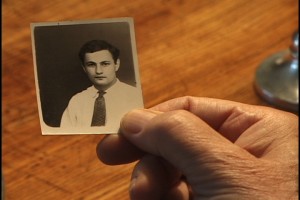The Last Happy Day by Lynne Sachs
Essay on film by Genna Cherichello
11/11/10
Topics in Rhetorical Theory: Visual Culture – Haverford College
In her experimental essay film The Last Happy Day, Lynne Sachs uses a variety of film types (super 8 home video, stock footage, still photographs), narrative content (interviews, letters, acted scenes) and other components to build her depiction of Sandor Lenard. A distant cousin of Sachs, Sandor was a medical doctor who worked for the U.S. Army Graves Registration Service, reconstructing skeletons out of the bones of dead American soldiers from World War II. After this position, he moved to Brazil where he lived reclusively and translated “Winnie the Pooh” into Latin. The concept of distance, made apparent by Sandor’s purposeful distancing from the realities of the Holocaust, is vital to the film. The various applications and iterations of distance shape the filmic language and afford the viewer an avenue of access to what the film says about war, the Holocaust, and how we see.
The eye as a mediator is only able to focus on one thing at a time, with everything around that point of focus being lost to obscurity; this forces a piecemeal understanding of one’s environment. The filmic eye in The Last Happy Day, too, is an obscuring and complicating force, which helps to form the film’s language. Sachs manipulates her camera very deliberately, employing the difference between sharp-focus and soft-focus. Her camera is dizzying. It sees through things: focuses on one and alters its focus to another, all within the same line of sight. The constant focus adjustments during the scenes of “Winnie the Pooh” rehearsal create a distance between the viewer and the subject, one maintained by the filmmaker’s hand. The camera sometimes focuses on objects in the periphery instead of the person in the shot, such as the scene where the purple flowers and candles are clear, and clearly disabling focused sight of the scene’s human subjects. Sachs manipulates the fluidity of the focus, often shifted in a choppy, unnatural way, reminiscent of being submitted to a prescription exam at the eye doctor. This, coupled with the tendency of heavy background light to darken heavily the foreground, add to the camera’s role in distancing the viewer from the filmic subjects.
Not only does Sachs’s particular camera technique create a distance within the film’s rhetoric, but Sandor’s intentional distancing from the war does so within the narrative. Sandor distances himself emotionally and physically from the war, but he also denies his distancing. The film separates the viewer from the reality of the mass grave by including abstracted, duo-toned stock footage of war with Sandor’s words about the bones. These words, even, were in a letter to someone who is neither the director nor the viewer, and the voice is obviously not Sandor’s. These are two additional layers of distance between perceiving what is presented and attempting to understand it.
Eventually, the film’s distancing procedures end up illuminating the narrative, perhaps more than if the story that develops through the experimental techniques was told in an actual narrative-style film. This is seen particularly strongly in the scene where the young girl who plays Christopher Robin is describing death after being introduced to the topic through Sandor’s Latin translation of “Winnie the Pooh.” His word choice was colored with sterile negativity, free of emotion and full of fact. It permitted the girl to explore and explain the concepts of depression, death, and the desire for death in a way that would perhaps be impossible without the mediating force of a dead language. The distancing tropes of film overall perform the same type action for the viewer, allowing access to understanding of the premise and the subjects that would have otherwise been impossible.

